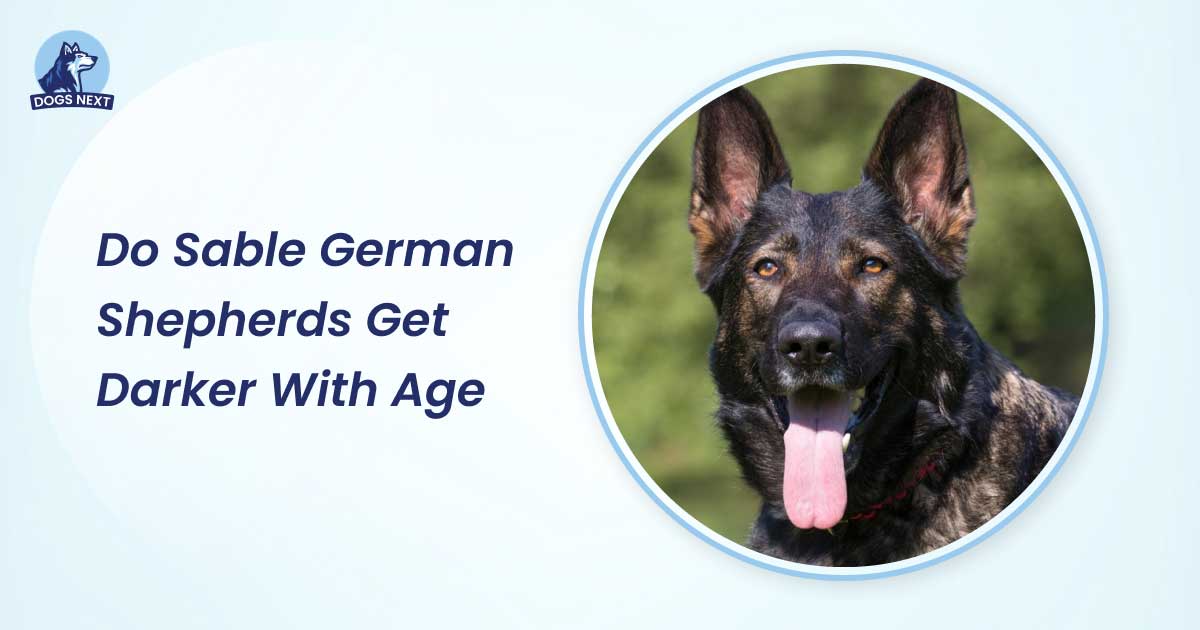Yes, sable German Shepherds often get darker with age. Their coat color can change significantly as they mature.
Sable German Shepherds are known for their unique and dynamic coat colors. As puppies, they usually have lighter fur, which gradually darkens over time. This color change is a natural part of their development and can vary from dog to dog.
The darkening process can continue into adulthood, resulting in a rich and varied coat. This transformation makes sable German Shepherds particularly striking and attractive. Understanding their coat evolution helps potential owners appreciate the breed’s beauty and uniqueness. This information is crucial for those considering a sable German Shepherd, as it ensures they are prepared for the changing appearance of their furry friend.
Coat Color Changes Over Time
Sable German Shepherds are known for their unique and beautiful coat colors. Many dog owners wonder if these dogs get darker as they age. Understanding the coat color changes over time can help you anticipate how your dog’s appearance might evolve.
Normal Coat Changes In Gsds
German Shepherds, including Sable German Shepherds, often experience normal coat changes throughout their lives. These changes are part of their natural development and can vary based on genetics and other factors.
Here are some common coat changes in GSDs:
- Puppy Coat: German Shepherd puppies are born with a soft, fluffy coat that eventually sheds.
- Adolescent Coat: As they grow, their coat becomes denser and changes in texture.
- Adult Coat: By the time they reach adulthood, their coat will have its final texture and color.
In some cases, you might notice gradual changes in the coat color over time. This is normal and varies from dog to dog.
Why Some Dogs Get Darker
Not all Sable German Shepherds experience the same coat color change. Some dogs get darker due to several factors:
- Genetics: Genetic makeup plays a significant role in the coat color variation. Some genes cause darker coats.
- Sun Exposure: Prolonged exposure to the sun can darken a dog’s coat over time.
- Health and Diet: A dog’s health and diet can influence coat color. Nutrients and overall health impact their appearance.
Understanding these factors can help you better anticipate changes in your sable German Shepherd’s coat. Regular grooming and a healthy diet can also help maintain their beautiful coat.
Age-related Coat Transformations
As Sable German Shepherds age, their coat undergoes age-related transformations. These changes can be subtle or more pronounced, depending on the individual dog.
Here are some age-related coat changes:
- Puppy to Adult: Puppies often have lighter coats that darken as they mature.
- Senior Years: Older dogs might experience graying or lightening of their coat, particularly around the muzzle and eyes.
- Seasonal Changes: Some dogs exhibit seasonal coat changes, with darker coats in winter and lighter in summer.
It’s important to note that these transformations are natural and part of the life cycle of a Sable German Shepherd. Regular grooming and care will help keep their coat healthy and vibrant throughout their life.
Factors That Affect Coat Darkening
Do sable German Shepherds get darker with age? This intriguing question often fascinates dog lovers and owners. Various factors contribute to the coat darkening in sable German Shepherds. Understanding these factors can help in predicting and managing the coat changes over time. Let’s explore the key factors that affect coat darkening in these majestic dogs.
Genetic Influences
Genetic factors for dog coat color play a significant role in the coat darkening of sable German Shepherds. The coat color is primarily determined by genes inherited from their parents. These genes control the distribution and type of pigments in the dog’s fur.
The key genetic influences include:
- Agouti gene: This gene determines the sable pattern in German Shepherds. It regulates the color distribution across each hair strand, leading to a blend of light and dark shades.
- Color intensity genes: Some genes control the intensity of the coat color. These genes can make the coat appear darker or lighter as the dog ages.
- Inheritance patterns: The genetic makeup of the parents influences the coat color of their offspring. If both parents have dark sable coats, their puppies are more likely to have darker coats as they mature.
Overall, genetics play a crucial role in determining whether a sable German Shepherd’s coat will darken with age.
Diet And Health Impacts
Diet and health significantly impact the coat color and quality of sable German Shepherds. Proper nutrition and overall health can affect the coat’s appearance over time.
Essential nutrients:
- Proteins: High-quality proteins are vital for maintaining a healthy coat. Proteins help in the production of keratin, the main component of hair.
- Omega-3 and Omega-6 fatty acids: These fatty acids are crucial for a shiny and healthy coat. They help in reducing inflammation and promoting skin health.
- Vitamins and minerals: Vitamins like A, E, and B-complex, along with minerals like zinc and copper, are essential for coat health. They aid in maintaining the coat’s color and texture.
Health conditions:
- Hormonal imbalances: Conditions like hypothyroidism can lead to coat changes, including darkening or dullness.
- Allergies: Skin allergies can affect the coat’s health and color. Proper management of allergies is crucial for maintaining a healthy coat.
Ensuring a balanced diet and addressing health issues can help in maintaining the coat color and quality of sable German Shepherds.
Environmental Factors
Environmental factors also play a role in the coat color changes of sable German Shepherds. The environment affecting dog coats can lead to noticeable changes over time.
Sun exposure:
- Prolonged exposure to sunlight can lead to coat bleaching. The UV rays can lighten the coat, making it appear less dark.
- Adequate shade and protection from direct sunlight can help in maintaining the coat’s natural color.
Climate:
- Extreme weather conditions can affect the coat’s quality. Cold weather can lead to a thicker and darker coat due to increased melanin production.
- In hot climates, the coat may become lighter as the dog sheds more frequently.
Living conditions:
- Indoor dogs may have different coat changes compared to outdoor dogs. Indoor dogs are less exposed to harsh environmental factors, leading to a more consistent coat color.
- Outdoor dogs may experience more significant coat changes due to varying weather conditions and sun exposure.
Understanding what affects dog coat color can help in managing the coat changes in sable German Shepherds effectively.
When To Expect Changes
The coat of a Sable German Shepherd is a fascinating aspect of this breed, and many owners wonder if their dog’s coat will darken with age. Understanding the different phases of coat development can help you know when to expect changes. Let’s dive into the stages from puppyhood to adulthood and identify the signs of coat maturation.
Changes During Puppyhood
The early stages of a Sable German Shepherd’s life are marked by rapid changes in their coat color. During puppyhood, their coat undergoes several transformations:
- Birth to 8 weeks: Puppies are born with a soft, fluffy coat. This initial coat is often lighter in color and lacks the distinct sable pattern.
- 8 weeks to 6 months: As puppies grow, their coat starts to change. You may notice darker hairs appearing, especially along the back and on the face.
- 6 months to 1 year: The coat begins to thicken and darken. The sable pattern becomes more pronounced, and you can see a mix of lighter and darker hairs.
During these early months, it’s normal to see a variety of colors and patterns in your Sable German Shepherd’s coat. These changes are part of the natural progression as they mature.
Adult Coat Development
As Sable German Shepherds transition from puppyhood to adulthood, their coat undergoes further changes. The adult coat development stage is crucial for achieving the final look of the dog:
- 1 to 2 years: During this period, the coat continues to darken and thicken. The sable pattern becomes more defined.
- 2 to 3 years: This is when the adult coat fully develops. The colors become richer, and the texture of the coat changes to a more coarse and dense structure.
German Shepherd coat phases during this time can vary, but generally, the coat will settle into its final color and texture by the age of 3. Regular grooming helps maintain the coat and enhances its natural beauty.
Signs Of Coat Maturation
Recognizing the signs of coat maturation in your Sable German Shepherd is key to understanding their development stages. Here are some indicators that your dog’s coat is maturing:
- Color consistency: The coat color becomes more uniform with fewer patches of lighter or darker hair.
- Coat texture: A mature coat is typically thicker and coarser compared to the soft puppy fur.
- Pattern clarity: The sable pattern becomes more distinct and well-defined as the dog matures.
By observing these signs, you can track the progression of your Sable German Shepherd’s coat. Understanding the dog coat maturity timeline helps you appreciate the beautiful, evolving nature of their appearance.
Frequently Asked Questions
Do Sable German Shepherds Change Color As They Age?
Yes, sable German Shepherds often darken with age. Their coat color can shift due to genetic factors.
Why Do Sable German Shepherds Get Darker?
Sable German Shepherds get darker due to melanin changes. Their fur color evolves naturally over time.
At What Age Do Sable German Shepherds Darken?
Sable German Shepherds typically darken around 1-3 years old. The process varies by individual dog.
Can Sable German Shepherds Lighten With Age?
Rarely, but some sable German Shepherds may lighten. However, darkening is more common due to genetics.
Conclusion
Sable German Shepherds often darken as they age, showcasing their unique beauty. This color change is gradual but noticeable. Proper care ensures their coat remains healthy. Understanding this trait helps owners appreciate their pet’s evolving appearance. Love and care make their journey even more special.

I’m David, an expert contributor and writer, with two furry friends of my own, I know the challenges of raising and caring for dogs. From training to nutrition and health, my goal is to provide valuable insights and advice to help create strong bonds and happy, healthy lives. Find me in Twitter.




